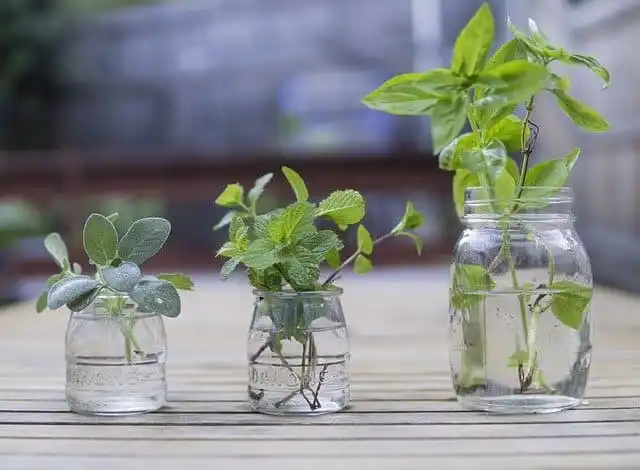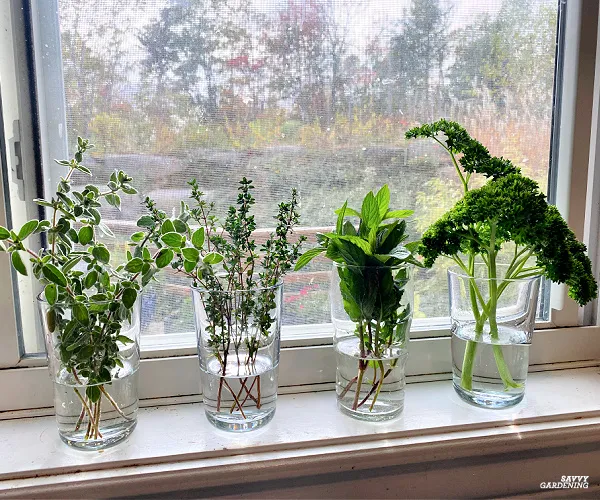Grow herbs in water? Discover the wonders of hydroponic gardening with herbs that grow in water. Explore different techniques, herb options, and the simplicity of cultivating a thriving herb garden without soil.
Imagine a windowsill adorned with glass jars filled with thriving herbs, their roots dancing in crystal-clear water. Herbs that grow in water are a delightful and low-maintenance way to bring the magic of gardening into even the smallest of spaces.
In this article, we’ll explore how to grow herbs in water, uncovering the benefits, methods, and the joy of cultivating herbs in water, all without the need for traditional soil gardening.
Water-grown herbs offer a unique and innovative way to enjoy the beauty and flavor of fresh herbs. By diving into the world of hydroponic herb gardening, you’ll discover a method that’s not only convenient but also visually captivating.
Embracing Hydroponic Herb Gardening
Hydroponic gardening involves growing plants in water rather than soil:
- Soil-Free Cultivation: Hydroponic systems provide plants with essential nutrients through water, eliminating the need for traditional soil.
- Space Efficiency: Water-grown herbs are perfect for small spaces like windowsills, making gardening accessible to everyone.
Popular Herbs for Water Cultivation
Growing herbs in water, also known as hydroponic or aquatic herb gardening, can be a unique and visually appealing way to cultivate herbs. Here are some popular herbs that can thrive in water cultivation:
- Basil (Ocimum basilicum):
- Basil is known for its aromatic leaves and is commonly used in cooking.
- It can be grown in water by placing cuttings in a container of water, allowing them to root and grow.
- Mint (Mentha spp.):
- Mint is a fast-growing herb with a refreshing fragrance and various culinary uses.
- It can be propagated from cuttings and grown in water. Make sure to give it enough space as it can become invasive.
- Lemongrass (Cymbopogon citratus):
- Lemongrass has a lemony flavor and is often used in teas, soups, and Asian cuisine.
- Place a stalk in water and it will develop roots, allowing you to grow it hydroponically.
- Oregano (Origanum vulgare):
- Oregano is a flavorful herb commonly used in Mediterranean and Italian dishes.
- Like basil, oregano cuttings can be placed in water to root and grow.
- Chives (Allium schoenoprasum):
- Chives have a mild onion flavor and are great for garnishing dishes.
- Propagate chives by dividing established plants and placing them in water.
- Lemon Balm (Melissa officinalis):
- Lemon balm has a lemony scent and is often used in herbal teas and culinary dishes.
- It can be propagated from stem cuttings and grown in water.
- Spearmint (Mentha spicata):
- Spearmint is a popular herb with a fresh flavor, commonly used in beverages and desserts.
- Similar to other mints, it can be propagated and grown in water.
- Stevia (Stevia rebaudiana):
- Stevia is a natural sweetener plant with leaves much sweeter than sugar.
- It can be grown hydroponically by rooting cuttings in water.
- Watercress (Nasturtium officinale):
- Watercress is a semi-aquatic plant with a peppery flavor, often used in salads and sandwiches.
- It thrives in water and can be grown in containers with a constant supply of water.
- Vietnamese Coriander (Persicaria odorata):
- Also known as “rau răm,” this herb has a unique flavor and is commonly used in Vietnamese cuisine.
- It can be propagated in water and grown hydroponically.
When growing herbs in water, it’s important to change the water regularly to prevent stagnation and ensure a healthy environment for root growth. Use clean, non-chlorinated water or let tap water sit out for a day to allow chlorine to dissipate before using.
Different Techniques for Water-Grown Herbs
There are various methods to grow herbs in water, each with its unique advantages:
- Jar Method: Place herb cuttings in water-filled glass jars, allowing roots to develop over time.
- Hydroponic Systems: Explore ready-made hydroponic kits designed for indoor herb cultivation.
Initiating Water Cultivation
Starting your water-grown herb garden is a simple and enjoyable process:
- Selecting Cuttings: Choose healthy stem cuttings from mature herb plants for propagation.
- Root Development: Place the cuttings in water, ensuring that only the nodes are submerged. Change the water regularly to prevent stagnation.
Providing Nutrients for Water-Grown Herbs
Although hydroponic systems rely on water for nutrients, you can supplement their growth with appropriate solutions:
- Hydroponic Nutrient Solutions: These solutions provide essential minerals and nutrients required for healthy growth.
- Maintaining pH Levels: Monitor and adjust the pH of the water to ensure optimal nutrient absorption.
Care and Maintenance of Water-Grown Herbs
Caring for water-grown herbs requires attention to their needs:
- Water Quality: Use clean, filtered water to prevent the buildup of impurities that can harm the plants.
- Light Exposure: Place your water-grown herbs in a spot that receives adequate sunlight or use grow lights to simulate sunlight.
7. Transitioning to Soil
While water cultivation is convenient, you can choose to transition your herbs to soil:
- Hardening Off: Gradually expose your water-grown herbs to outdoor conditions to acclimate them to soil.
- Transplanting: Carefully transfer the herbs to well-draining soil, ensuring their roots are covered and supported.
Conclusion
Tips From Experienced Gardener: 🌱
“Remember to change the water regularly to prevent stagnation and provide your water-grown herbs with the right nutrients. Be patient as you watch them flourish.”
FAQs
Q: Can I grow all herbs in water?
A: While many herbs can be grown in water, some may not thrive without soil. It’s best to research each herb’s specific requirements.
Q: Do water-grown herbs taste the same as soil-grown herbs?
A: Water-grown herbs can have flavors and aromas similar to their soil-grown counterparts, but their intensity might vary.
Q: Can I use tap water for hydroponic gardening?
A: It’s recommended to use filtered or dechlorinated water to prevent the buildup of chemicals that can affect plant growth.
Growing herbs in water open a world of gardening possibilities, allowing you to savor the beauty of plants without the need for traditional soil. By exploring different methods, choosing suitable herbs, and attending to their care, you’ll create a unique and captivating herb garden that’s as rewarding as it is visually stunning. The simplicity and elegance of water-grown herbs redefine the art of indoor gardening.
Fun Fact: Did you know that the ancient hanging gardens of Babylon, one of the Seven Wonders of the Ancient World, used a form of hydroponic gardening to cultivate plants without soil? 🌿💧
In conclusion, the journey of cultivating herbs in water is a voyage into the realm of innovation and creativity. As you witness your herbs thrive in their aquatic homes, you’ll find a deep sense of satisfaction in nurturing their growth and savoring their bounty. Happy hydroponic gardening! 🌱💧
Originally posted 2023-02-09 10:21:53.



